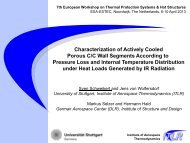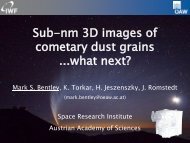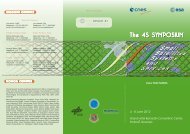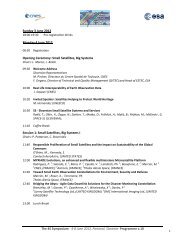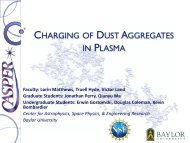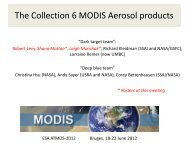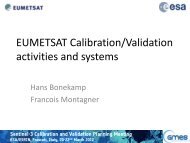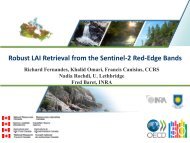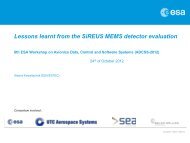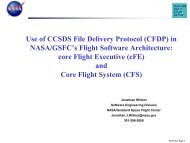InSAR Error Analysis in Measuring Coseismic Deformation of 2008 ...
InSAR Error Analysis in Measuring Coseismic Deformation of 2008 ...
InSAR Error Analysis in Measuring Coseismic Deformation of 2008 ...
You also want an ePaper? Increase the reach of your titles
YUMPU automatically turns print PDFs into web optimized ePapers that Google loves.
<strong>InSAR</strong> <strong>Error</strong> <strong>Analysis</strong> <strong>in</strong> Measur<strong>in</strong>g<br />
<strong>Coseismic</strong> <strong>Deformation</strong> <strong>of</strong> <strong>2008</strong><br />
Damxung M w 6.3 Earthquake<br />
Zhang J<strong>in</strong>gfa Liu B<strong>in</strong> and Lu Yi<br />
Institute <strong>of</strong> Crustal Dynamics, Ch<strong>in</strong>a Earthquake Adm<strong>in</strong>istration<br />
100085, Beij<strong>in</strong>g, Ch<strong>in</strong>a
CONTENTS<br />
Geological & Seismological Background<br />
<strong>Coseismic</strong> <strong>Deformation</strong> Measurement<br />
<strong>Error</strong> <strong>Analysis</strong> <strong>in</strong> <strong>InSAR</strong> Process<strong>in</strong>g<br />
The <strong>Deformation</strong> Rates Time Series <strong>Analysis</strong><br />
Conclusions
CONTENTS<br />
Geological & Seismological Background<br />
<strong>Coseismic</strong> <strong>Deformation</strong> Measurement<br />
<strong>Error</strong> <strong>Analysis</strong> <strong>in</strong> <strong>InSAR</strong> Process<strong>in</strong>g<br />
The <strong>Deformation</strong> Rates Time Series <strong>Analysis</strong><br />
Conclusions
Geological & Seismological Features<br />
October 6, <strong>2008</strong>,<br />
Damxung Earthquake<br />
The Mw6.3 earthquake,<br />
located: 90.3E, 29.8N (CENC),<br />
Depth: 8.0 km.
Geological & Seismological Features
Geological & Seismological Features
Geological & Seismological Features
Geological & Seismological Features
Geological & Seismological Features
CONTENTS<br />
Geological & Seismological Background<br />
<strong>Coseismic</strong> <strong>Deformation</strong> Measurement<br />
<strong>Error</strong> <strong>Analysis</strong> <strong>in</strong> <strong>InSAR</strong> Process<strong>in</strong>g<br />
The <strong>Deformation</strong> Rates Time Series <strong>Analysis</strong><br />
Conclusions
CONTENTS<br />
Geological & Seismological Background<br />
<strong>Coseismic</strong> <strong>Deformation</strong> Measurement<br />
<strong>Error</strong> <strong>Analysis</strong> <strong>in</strong> <strong>InSAR</strong> Process<strong>in</strong>g<br />
The <strong>Deformation</strong> Rates Time Series <strong>Analysis</strong><br />
Conclusions
Descend<strong>in</strong>g path<br />
Strip T176
Ascend<strong>in</strong>g path<br />
Strip T26
Numerical Simulation<br />
Surface deformation and stress<br />
distribution<br />
<strong>of</strong> the Dumxung earthquake<br />
(Ux: deformation <strong>of</strong> NS; Uy: WE;<br />
Uz: vertical;<br />
Sxx: normal stress <strong>of</strong> NS;<br />
Syy: WE;Sxy: shear)
Numerical Simulation<br />
Horizontal surface displacement <strong>of</strong> Dumxung earthquake. Left: Vertical<br />
displacement <strong>of</strong> co-seismic deformation(mm); Right:Post-seismic<br />
deformation rate 50 years after the earthquake(mm/a)
Numerical Simulation<br />
Vertical displacements.<br />
Left: co-seismic deformation<br />
(mm);<br />
Right: deformation rate after<br />
50 years (mm/a)
CONTENTS<br />
Geological & Seismological Background<br />
<strong>Coseismic</strong> <strong>Deformation</strong> Measurement<br />
<strong>Error</strong> <strong>Analysis</strong> <strong>in</strong> <strong>InSAR</strong> Process<strong>in</strong>g<br />
The <strong>Deformation</strong> Rates Time Series <strong>Analysis</strong><br />
Conclusions
CONTENTS<br />
Geological & Seismological Background<br />
<strong>Coseismic</strong> <strong>Deformation</strong> Measurement<br />
<strong>Error</strong> <strong>Analysis</strong> <strong>in</strong> <strong>InSAR</strong> Process<strong>in</strong>g<br />
The <strong>Deformation</strong> Rates Time Series <strong>Analysis</strong><br />
Conclusions
• The best result <strong>of</strong> Damxung Earthquake D-<br />
<strong>InSAR</strong> image was taken as standard, and some<br />
error factors will be studied accord<strong>in</strong>g to this<br />
base image.
The ma<strong>in</strong> <strong>in</strong>fluence factors <strong>in</strong> <strong>InSAR</strong> process<strong>in</strong>g<br />
Registration <strong>Error</strong><br />
Unwrapp<strong>in</strong>g methods<br />
Atmospheric path delays<br />
Basel<strong>in</strong>e error
Registration <strong>Error</strong> Between Master and Slave<br />
0 pixel deviation<br />
Interferogram Coherence
Registration <strong>Error</strong> Between Master and Slave<br />
0.5 0 pixel deviation<br />
Interferogram Coherence
Registration <strong>Error</strong> Between Master and Slave<br />
1 pixel deviation<br />
Interferogram Coherence
Registration <strong>of</strong> Master & Slave<br />
1.5 pixel deviation<br />
Interferogram Coherence
Registration <strong>Error</strong> Between Master and Slave<br />
5 pixel deviation<br />
Interferogram Coherence
Registration <strong>Error</strong> Between Master and Slave<br />
The relations between coherence and pixel deviations
Before deviat<strong>in</strong>g from the correct<br />
location about 1.5 pixels, there is a<br />
s<strong>in</strong>e function between coherence<br />
and step, while exceed<strong>in</strong>g 1.5<br />
pixels, the result will be unvalued.
Registration <strong>Error</strong> Between Master and DEM<br />
Orig<strong>in</strong>al images 5 pixels deviation 10 pixels deviation
This is Registration <strong>Error</strong> Between Master<br />
and DEM, from this image, the<br />
deformation accuracy is related to<br />
registration error.
Comparison <strong>of</strong> different unwrapp<strong>in</strong>g methods<br />
network flow<br />
branch cut<br />
m<strong>in</strong>imum discont<strong>in</strong>uity<br />
least-squares fr<strong>in</strong>ge track<strong>in</strong>g<br />
Conjugate Gradient
Comparison <strong>of</strong> different unwrapp<strong>in</strong>g methods<br />
comparative analysis <strong>of</strong> different unwraped methods
It is certa<strong>in</strong>ly that there is<br />
different <strong>in</strong>fluence degree<br />
<strong>in</strong> different unwrapp<strong>in</strong>g<br />
methods.
Topography correct atmospheric path delays<br />
Atmospheric path delays caused by topography<br />
Before correction<br />
After correction<br />
Descend<strong>in</strong>g path:<br />
T176
Topography correct atmospheric path delays<br />
Ascend<strong>in</strong>g path:T026<br />
Before correction After correction
Atmospheric path delays caused by topography<br />
Before correction<br />
Topography correct atmospheric path delays<br />
After correction<br />
Ascend<strong>in</strong>g path:<br />
WS T441 H/V
lhaz-GPS station<br />
Relations <strong>of</strong> GPS-PWV and MODIS-PWV<br />
L<strong>in</strong>ear relationship between GPS-PWV<br />
and MODIS-PWV, the <strong>in</strong>tegration <strong>of</strong> two<br />
data can correct atmospheric path delay<br />
<strong>of</strong> <strong>InSAR</strong>!<br />
ncrs-GPS station
The relation between atmospheric path delays<br />
and topography <strong>in</strong> Damxung area, there is a<br />
l<strong>in</strong>ear function.<br />
That is, the path delays vary l<strong>in</strong>early with height<br />
as a first-order approximation.
Effects <strong>of</strong> basel<strong>in</strong>e ref<strong>in</strong>ement<br />
T176
Effects <strong>of</strong> basel<strong>in</strong>e ref<strong>in</strong>ement<br />
T26
The effect <strong>of</strong> basel<strong>in</strong>e ref<strong>in</strong>ement is clear.
Basel<strong>in</strong>e deviation -3m<br />
2 专题研究内容 ----理论研究<br />
Basel<strong>in</strong>e is OK<br />
Basel<strong>in</strong>e deviation +3m
Basel<strong>in</strong>e deviation -3m<br />
2 专题研究内容 ----理论研究<br />
Basel<strong>in</strong>e is OK<br />
Basel<strong>in</strong>e deviation +3m
2 专题研究内容 ----理论研究<br />
0.2<br />
0.15<br />
0.1<br />
0.05<br />
0<br />
-0.05<br />
-0.1<br />
-0.15<br />
-0.2<br />
-3 -2 -1 0 1 2 3<br />
C点<br />
A点<br />
B点
The basel<strong>in</strong>e error will reduce the range<br />
<strong>of</strong> deformation field
CONTENTS<br />
Geological & Seismological Background<br />
<strong>Coseismic</strong> <strong>Deformation</strong> Measurement<br />
<strong>Error</strong> <strong>Analysis</strong> <strong>in</strong> <strong>InSAR</strong> Process<strong>in</strong>g<br />
The <strong>Deformation</strong> Rates Time Series <strong>Analysis</strong><br />
Conclusions
CONTENTS<br />
Geological & Seismological Background<br />
<strong>Coseismic</strong> <strong>Deformation</strong> Measurement<br />
<strong>Error</strong> <strong>Analysis</strong> <strong>in</strong> <strong>InSAR</strong> Process<strong>in</strong>g<br />
The <strong>Deformation</strong> Rates Time Series <strong>Analysis</strong><br />
Conclusions
The <strong>Deformation</strong> Rates Time<br />
Series <strong>Analysis</strong><br />
Time series analysis before the earthquake<br />
Time series analysis after the earthquake
Time series analysis before the earthquake<br />
Unwraped images <strong>of</strong> PS po<strong>in</strong>ts Orbital contribution<br />
DEM error<br />
Time series <strong>of</strong> deformation signal<br />
Atmospheric contribution
Time series analysis before the earthquake
Time series analysis before the earthquake<br />
PS-<strong>InSAR</strong> Time series<br />
<strong>of</strong> deformation signals<br />
SBAS-<strong>InSAR</strong> Time series<br />
<strong>of</strong> deformation signals
Time series analysis before the earthquake<br />
PS <strong>InSAR</strong> SBAS <strong>InSAR</strong>
Time series analysis before the earthquake<br />
PS <strong>InSAR</strong>
Time series analysis before the earthquake<br />
Standard deviations <strong>of</strong> the selected po<strong>in</strong>ts<br />
<strong>in</strong> 8 areas<br />
区域 A<br />
区域 B<br />
区域 C<br />
区域 D<br />
区域 E<br />
区域 F<br />
区域 G<br />
区域 H<br />
Lon Lat<br />
mean_v<br />
(mm/year)<br />
90.482 30.075 -6.74 0.61<br />
90.488 30.072 -7.78 0.76<br />
90.314 30.059 3.00 0.75<br />
90.310 30.059 2.33 0.69<br />
90.446 30.101 2.53 0.75<br />
90.464 30.121 3.30 0.72<br />
90.394 29.875 2.05 0.66<br />
90.384 29.887 1.63 0.53<br />
90.325 29.936 -1.04 0.49<br />
90.314 29.952 -1.73 0.45<br />
90.252 30.165 -3.82 1.62<br />
90.313 30.121 -1.92 1.15<br />
90.575 29.975 -4.21 1.5<br />
90.598 29.980 -3.93 1.44<br />
90.207 29.995 2.3 1.48<br />
90.201 29.994 3.16 1.48<br />
Std<br />
(mm/year)
Time series analysis before the earthquake<br />
SBAS <strong>InSAR</strong>
Time series analysis before the earthquake<br />
Standard deviations <strong>of</strong> the selected po<strong>in</strong>ts <strong>in</strong> 8<br />
areas<br />
区域 A<br />
区域 B<br />
区域 C<br />
区域 D<br />
区域 E<br />
区域 F<br />
区域 G<br />
区域 H<br />
Lon Lat<br />
mean_v<br />
(mm/year)<br />
Std<br />
(mm/year)<br />
90.487 30.072 -7.20 0.62<br />
90.485 30.071 -7.23 0.65<br />
90.317 30.059 2.06 0.43<br />
90.317 30.06 2.28 0.29<br />
90.463 30.127 3.64 0.66<br />
90.464 30.125 3.15 0.54<br />
90.387 29.876 1.84 0.41<br />
90.381 29.881 2.21 0.45<br />
90.312 29.930 -1.11 0.33<br />
90.31 29.934 -0.98 0.32<br />
90.31 30.121 -6.08 0.6<br />
90.296 30.134 -5.93 0.82<br />
90.574 30.15 -4.21 0.86<br />
90.577 30.076 -2.07 0.78<br />
90.209 29.986 2.21 0.76<br />
90.217 29.984 3.68 0.85
The deformation rates from SBAS-<strong>InSAR</strong> and PS-<br />
<strong>InSAR</strong> time series analysis are consistent with<br />
each other.<br />
Obviously, the velocity <strong>in</strong> the edge <strong>of</strong> the bas<strong>in</strong><br />
is bigger than the place <strong>in</strong> the flat area.<br />
The maximum upward velocity reached<br />
3.1mm/year (LOS) and the maximum downward<br />
velocity reached -7.4mm/year (LOS).
In the north <strong>of</strong> the bas<strong>in</strong>, there is an area <strong>of</strong><br />
great downward trend. The reason is that<br />
there is one big geothermic plant and the<br />
pump<strong>in</strong>g <strong>of</strong> the geothermic cause the great<br />
ground subsidence
Time series analysis before the earthquake<br />
去噪后年形变速率(LOS)<br />
PS-meanv SBAS-meanv
Time series analysis before the earthquake<br />
PS mean_v l<strong>in</strong>es plot
Time series analysis before the earthquake<br />
SBAS mean_v l<strong>in</strong>es plots
Time series analysis before the earthquake<br />
The activities <strong>of</strong> faults <strong>in</strong> Yangbaj<strong>in</strong>g Bas<strong>in</strong><br />
A: -5~-8mm/a<br />
B:3~5mm/a<br />
C:-1.5~2.0mm/a
Time series analysis after the earthquake<br />
Damxung<br />
earthquake
Because <strong>of</strong> the impact <strong>of</strong> the<br />
aftershocks, <strong>in</strong> epicenter <strong>of</strong><br />
Damxung, there is still ground<br />
subsidence.
CONTENTS<br />
Geological & Seismological Background<br />
<strong>Coseismic</strong> <strong>Deformation</strong> Measurement<br />
<strong>Error</strong> <strong>Analysis</strong> <strong>in</strong> <strong>InSAR</strong> Process<strong>in</strong>g<br />
The <strong>Deformation</strong> Rates Time Series <strong>Analysis</strong><br />
Conclusions
CONTENTS<br />
Geological & Seismological Background<br />
<strong>Coseismic</strong> <strong>Deformation</strong> Measurement<br />
<strong>Error</strong> <strong>Analysis</strong> <strong>in</strong> <strong>InSAR</strong> Process<strong>in</strong>g<br />
The <strong>Deformation</strong> Rates Time Series <strong>Analysis</strong><br />
Conclusions
Conclusions<br />
1. The major perturb<strong>in</strong>g factors limit<strong>in</strong>g D-<strong>InSAR</strong> accuracy<br />
is as follows:<br />
(a)Registration between master image to slave;<br />
(b)Orbit <strong>Error</strong>;<br />
(c)Atmospheric propagation delay.
Conclusions<br />
2. The velocity <strong>in</strong> the edge <strong>of</strong> the bas<strong>in</strong> is bigger than the<br />
place <strong>in</strong> the flat area.<br />
In the epicenter <strong>of</strong> Damxung, there is still ground<br />
subsidence <strong>in</strong> a long time after the earthquake.




